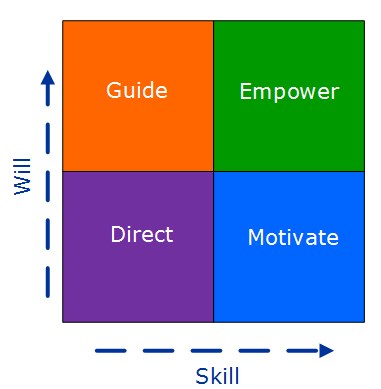The Skill Will Matrix is an easy to use tool to ensure that you can get the best out of your team & is a great way to make sure staff are aligned in the training and development process. The skill/will matrix was introduced by Max Landsberg in his book, The Tao of Coaching . Since then it has been widely adopted and is a useful method of ensuring that a coach’s style of interaction is matched to a coachee’s readiness for a particular task.
What is the Point of the Skill Will Matrix?
To inform decisions about how best to lead and manage individual members of a team to secure optimal performance within the context of a specific project. The exercise can help to improve interactions between managers and employees, trainers and trainees.

Key Questions
- For the SKILL Dimension
- What level of relevant skills does this person currently have (about the expectations of the project/programme)?
- For the WILL Dimension
- What level of motivation does this person have for securing the outcomes of this project /programme and for working as a team and for ensuring that they perform optimally?
Planning The Skill / Will Matrix
| Team member | Skill Will Classification | Strategy to secure optimal performance |
When would you use the Skill / Will Matrix?
- At the planning stage of a project/programme
- As a leadership team to inform a leadership strategy: how to secure all team members as advocates for the project/programme and to ensure their optimal performance
- As a leadership team to think through how leadership is demonstrated / what it means etc
Are there any rules for using the Skill / Will Matrix?
- Individual members of the leadership team are required to justify the classification of each team member. What evidence do we have?
- An agreed strategy for each team member that the whole leadership team signs up to, and possibly plays an active part in, is needed
Resources required for the Skill / Will Matrix
- one sheet of flip chart paper with the Skill Will Matrix drawn up and something to stick it onto the walls
- ‘Sticky notes’ each with the names of a team member on
- one sheet of flip chart paper with the Planning Matrix draw on
Ground Rules of the Skill / Will Matrix
- A Facilitator should always help the Team to work through the process
- Everyone is on equal footing, e. no hierarchy
- Everyone freely participates
- Focus on the evidence we have to inform the Skill Will classification
- Focus on the strategies that we have known to work in the past when completing the Planning Matrix, but also think out of the box!
Roles & Responsibilities
| Facilitator | Members of the leadership team |
| Does not provide any answers – complete objectivity is critical
Ensures everyone’s view is heard
Might be the team leader, a member of the team or depending on sensitivities, someone who has not been involved may be more appropriate |
Works through the process under the guidance of the facilitator
Listens to the viewpoints of others, their evidence and their view about leadership effectiveness
Works collaboratively with other members of the team to arrive at a consensus solution |
The Process Behind the Skill / Will Matrix
- The Facilitator outlines the purpose of the activity – “to arrive at a leadership plan to secure optimal performance from members of the project/programme ”
- The Facilitator outlines how the process will unfold, and sets the ‘Ground Rules’ (see separate slide).
- The Facilitator selects a ‘Sticky note’ with the name of a team member on it and asks the leadership team the ‘Key Questions’ to get their views about the allocation to a quadrant of the Skill Will Matrix and their reason. The Facilitator supports the group to move towards a consensus and then places the ‘Sticky note’ in the appropriate quadrant.
- The Facilitator repeats stage 3 with each project team
- The Facilitator completes columns 1 and 2 of the Planning Matrix
- The Facilitator supports the group to agree on a strategy to secure the optimal performance of each team member and records this in the Planning Matrix
Critical Questions for the Leadership Team
The aim is to have a team of strong Advocates ideally. At the very least, however, for the project to be successful, there needs to be a critical mass of Advocates.
- How do we move specific individuals from where they are now to being an advocate? Even the Advocates need be thought about carefully – they might all ‘burn out’!
- Can the advocates be used to do some ‘shifting’ of the resistors and blockers?
- How can this be managed and supported?
Applying the Skill / Will Matrix
- The calibration for each team member is relative to the others on the chart, i.e.
- Does this person (on the whole) have a greater or lesser level of skill or about the same?
- Is this person (on the whole) as committed to securing outstanding outcomes from the project/programme through their performance, or about the same?
- If the group doesn’t agree straight away on the Skill Will Matrix classification for a team member it’s important to press individuals for their evidence base
- Much value is derived from contested positions as it drives out fundamentals regarding leadership.
If you liked this information and would like more help with building your team effectively please contact us [email protected]



